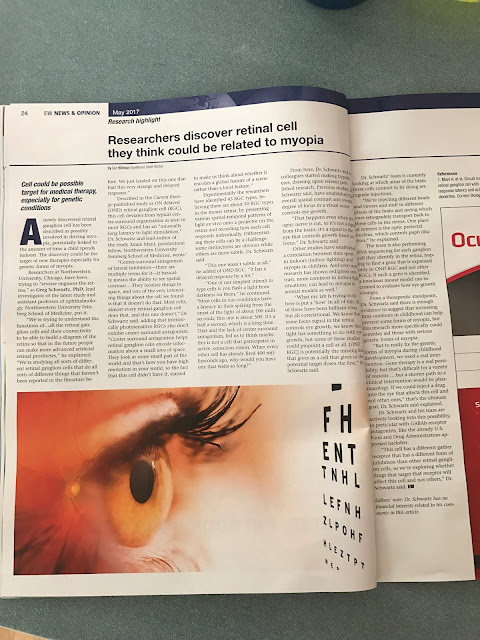While it may be too early still to announce a cure for myopia (nearsightedness which means usually the eyeball is longer than normal and the image needs the help of “minus” or “-” powered glasses to push the image onto the retina as the image focuses in front of the retina), researchers at Northwestern University in Chicago have made a big step.
They may have discovered a Retinal Cell that may explain why the eyeball grows and causes Myopia.
When you look at your computer screen, especially if you are a child, the light hits the front of your eye and enters the pupil. It then enters into the retina and bounces off the retina to some extent. Signals of that light to the eye determine the growth of the eye: this even happens if the Optic Nerve is cut completely. That means that if you had an eye looking at a computer screen for hours a day, even if the optic nerve did not connect to the brain, that eyeball would grow! Fascinating!
If you stare at the computer or video games or iphone for too long, you make your eyeball grow faster.
It is known there is a relationship between time spent indoors and myopia (ie, needing glasses) in kids. Also Red/green contrast, which is more common indoors than outdoors, can lead to myopia in animal models. Does this mean you should NEVER have a red/green night light? Likely Yes! We know night lights in general increase risk of myopia in kids, so definitely do not put it on the red/green setting!
I have always suspected that pupil changes affect eye growth as well. My theory is that while reading books for hours a day, can also cause myopia, reading a book is not as bad as reading on a Kindle or ipad or computer or iphone. Why? Because when you turn the page, the pupil has to refocus and you are more likely to look away into the distance with every turn of the page.
With a computer, kids and adults alike stare for hours and hours: sometimes without a break (think of that scene in the movie about Facebook where the coder’s code for hours through the night). Many people and kids watch movies and play video games for hours and barely look away. The pupil stays fixed. The signals continually tell the eyeball to “GROW, GROW, GROW!”
And now we are seeing increasing international epidemic rates of Myopia and it’s associated issues or Retinal Holes, Retinal Detachment, Posterior Vitreous Detachment, Debilitating Floaters, Cataract, and Glaucoma. This is not to mention the epidemic of Dry Eye symptoms/disease and Meibomian Gland Disease and Death (MGDD) I am seeing in young kids!
So these researchers say: They found a new cell type called ON delay Retinal Ganglion Cells:
ON delay Retinal Ganglion Cells:
OND RGC
-does not have Center surround antagonism:
-long latency to light stimulation: unusually long
encodes global feature of a scene instead of a local feature
Center surround antagonism:
-also known as Lateral Inhibition
-helps you see spatial contrast
-helps Retinal Ganglion Cells (RGCs) encode information about a small space area, which gives our vision high resolution.
-present in almost all RGS except the OND RGC and Intrinsically Photosensitive RGCs
Thus the researchers are doing retrograde injections into the brain to find which ones transport back to the new cells they found.
-they are very interested in the Optic Pretectal Nucleus which controls Pupil Dilation
-they are looking for drugs that could inhibit the new cell to see if that would stop Myopia
-they are looking at Baclofen which is a GABAb receptor antagonist already FDA approved for other conditions: they will conduct these experiments first on mice.


